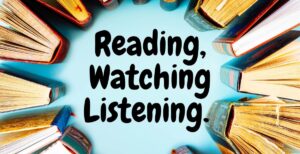
In this article we will rate the effectiveness of different learning methods. Reading, watching, and listening depends on various factors, including the nature of the material, the learner’s personal preferences, and the context of learning. Here’s how the three different methods compare.
Reading
Advantages:
– Depth and Detail: Reading allows for deep engagement with the material. Readers can pause, reflect, and re-read sections to enhance understanding.
– Pacing: Readers control the pace at which they consume information, which can be adjusted to fit their comprehension speed.
– Retention: Active reading strategies (e.g., note-taking, highlighting) can improve retention and recall.
– Comprehension: Complex and abstract concepts are often better understood through detailed reading.
Disadvantages:
– Time-Consuming: Reading can be more time-consuming than watching or listening to the same content.
– Motivation: Some learners may find reading less engaging or harder to stay focused on, especially for long texts.
Watching
Advantages:
– Visual and Auditory Engagement: Videos can combine visual and auditory elements, making the material more engaging and easier to understand for some learners.
– Demonstrations: Watching is particularly effective for learning tasks that involve physical activities or demonstrations (e.g., cooking, scientific experiments).
– Attention: Videos can capture and maintain learners’ attention more effectively than static text.
Disadvantages:
– Pacing: Videos progress at a set pace, which may be too fast or slow for different learners. Pausing and replaying can help but disrupts the flow.
– Retention: Passive watching can lead to lower retention compared to active reading unless accompanied by interactive elements (e.g., quizzes).
Listening
Advantages:
– Flexibility: Listening to audio content (e.g., podcasts, lectures) can be done while multitasking (e.g., commuting, exercising).
– Accessibility: Useful for auditory learners and for consuming content in situations where reading or watching is impractical.
Disadvantages:
– Attention and Retention: Passive listening may result in lower retention compared to active engagement methods. Taking notes can mitigate this.
– Complexity: Complex and highly detailed information might be harder to grasp through listening alone without visual aids.
Comparative Research Findings
1. Multimodal Learning: Combining multiple methods (reading, watching, and listening) often leads to better learning outcomes than using a single method. For example, a study might show that students who read and watch a video on the same topic perform better than those who only read or watch .
2. Learning Styles: Individual preferences and learning styles significantly impact effectiveness. Visual learners might benefit more from videos, while auditory learners might prefer listening .
3. Engagement and Interactivity: Interactive elements, such as quizzes and discussions, can enhance learning across all methods .
Conclusion
No single method is universally superior. A combination of reading, watching, and listening, tailored to the learner’s preferences and the nature of the material, typically promotes the best learning outcomes. To conclude, individual preferences have a huge factor to play here, for me personally I feel reading is better for learning as it requires full concentration but I am partial to audiobooks and podcasts while hiking or driving. Find out what works for you and if you are getting results then keep doing what you are doing.
